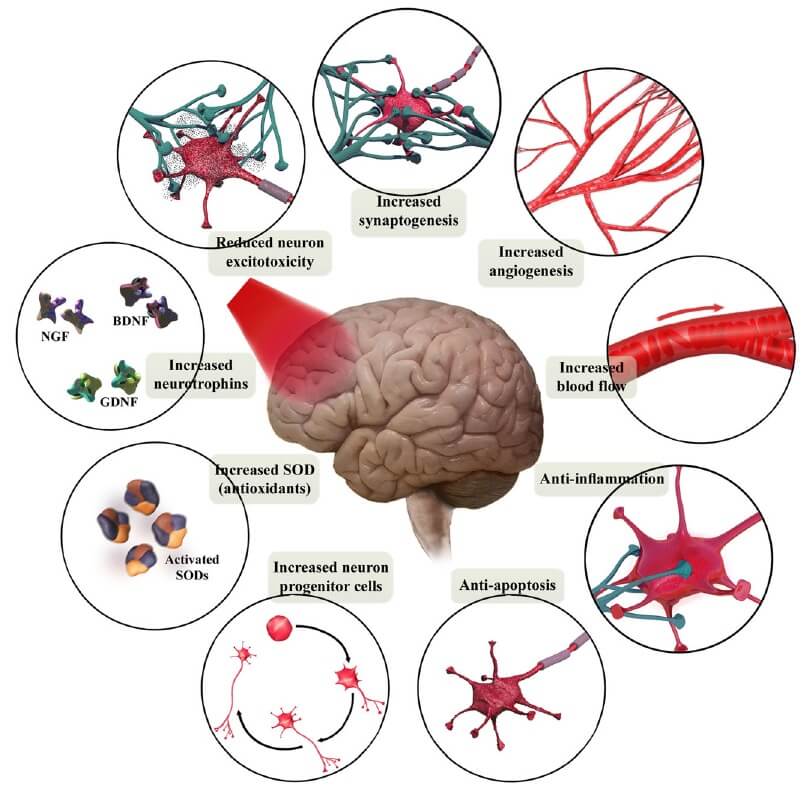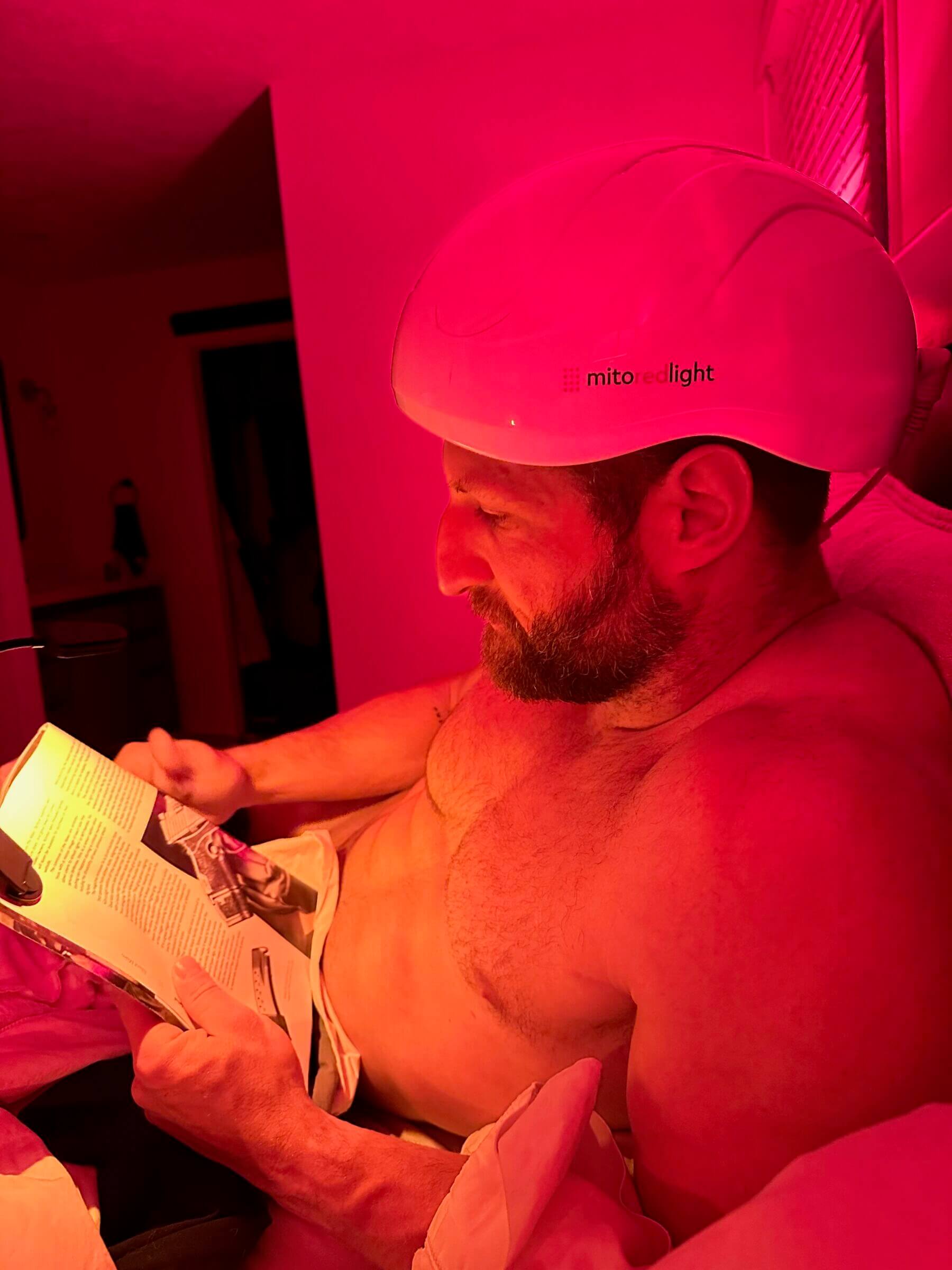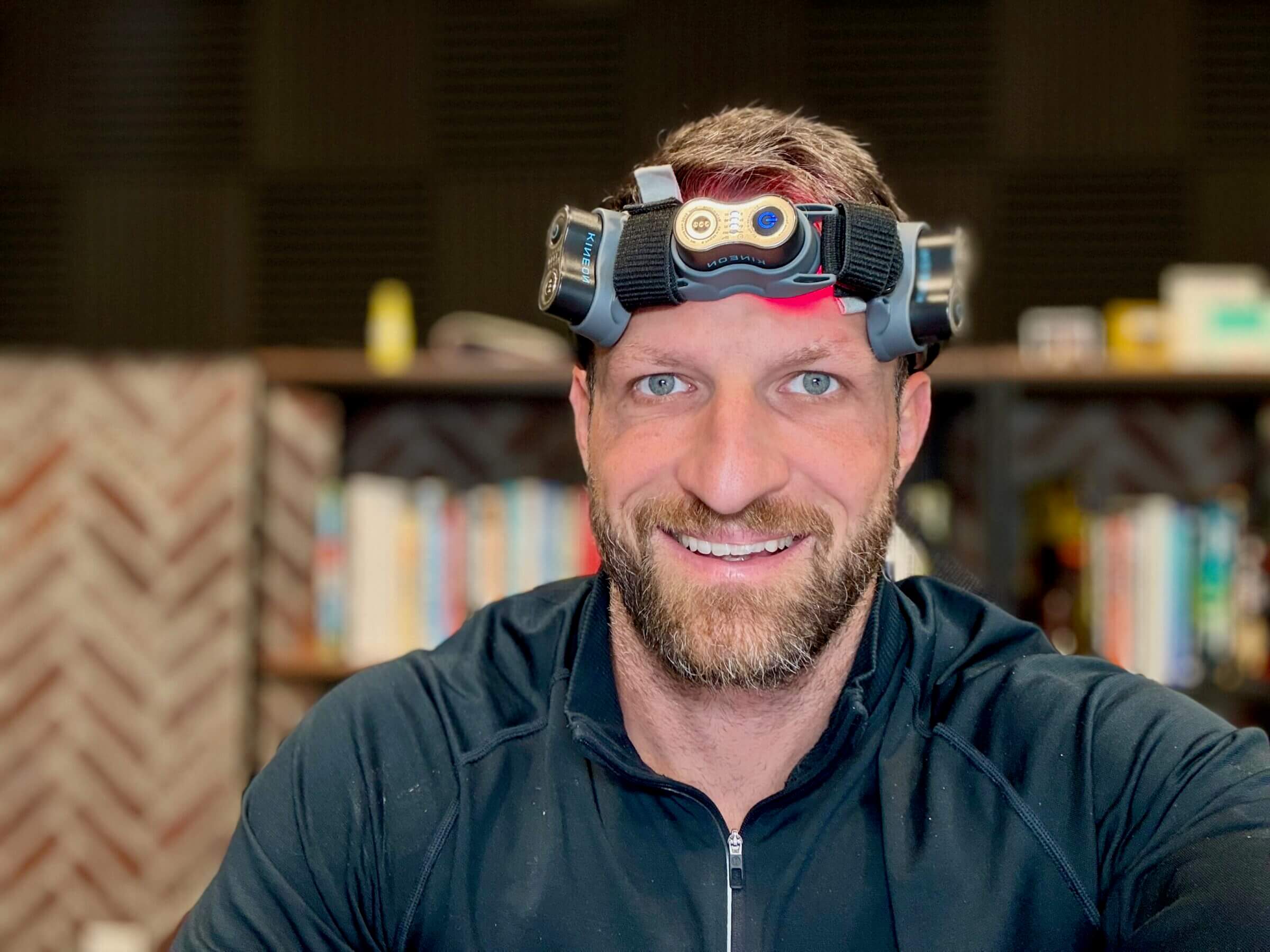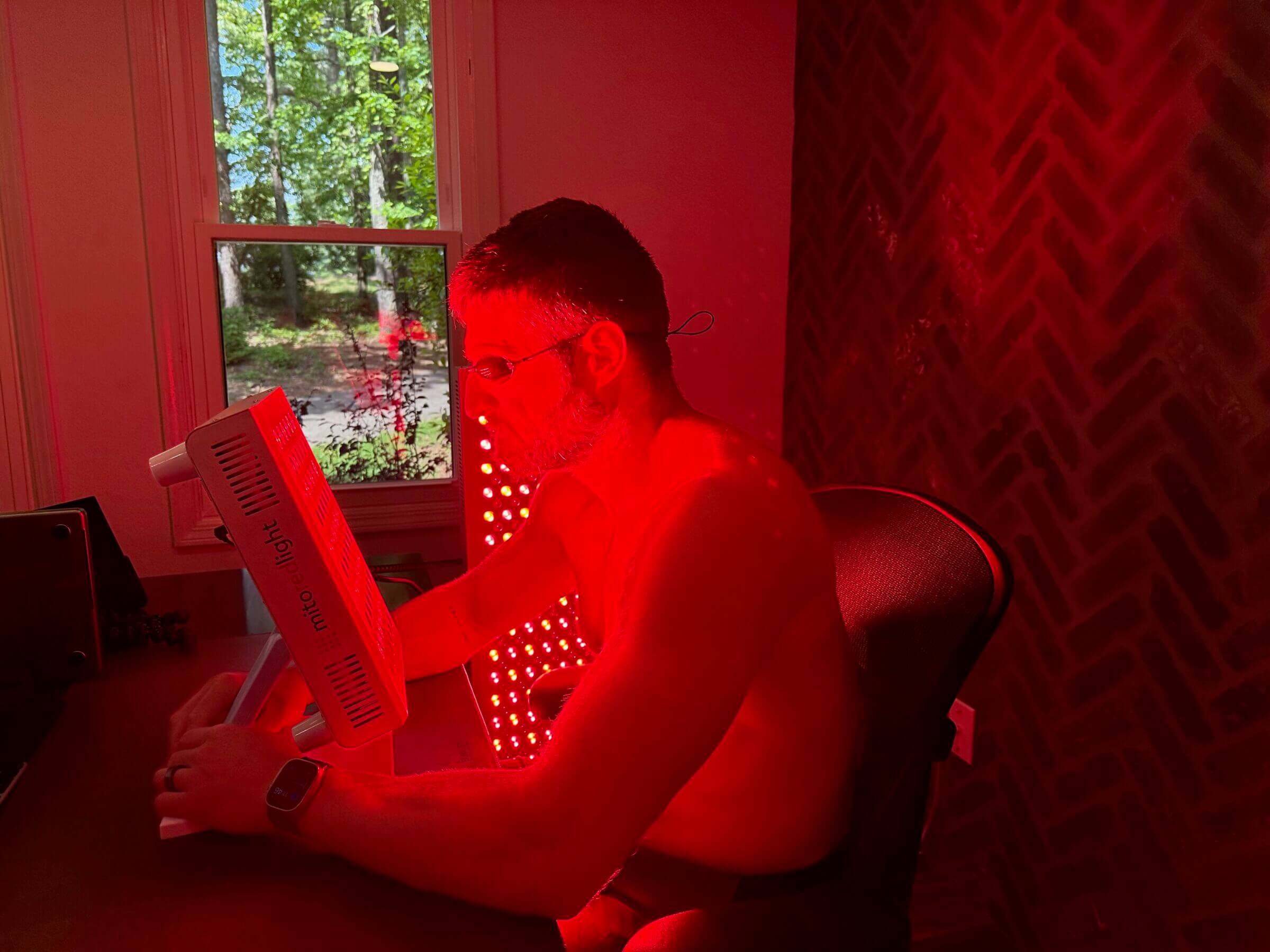Red light therapy leverages a combination of low-wavelength red and near-infrared light to penetrate skin and bone tissue and stimulate energy production in the mitochondria (our cells’ power plants). It’s an increasingly popular strategy for improving skin, joint and muscle health, but research shows it also offers impressive benefits for the brain.
For example, one study found that RLT can help protect neurons by promoting mitochondrial function, reducing oxidative stress, and increasing cerebral blood flow. Another study noted that red light shows promise in improving cognitive function in patients who suffered traumatic brain injuries.
How Red Light Impacts the Brain

In a nutshell, red light therapy supports brain health by positively influencing energy production within the mitochondria of your brain cells.
Mitochondria have photoreceptor enzymes (called cytochrome c oxidase) that respond to the unique frequencies of red and near-infrared light. When exposed to those frequencies, the photoreceptors increase the electron-to-oxygen transfer rate, which leads to an increase in adenosine triphosphate (ATP) production.
ATP is a molecule that stores and provides energy for cells in all living organisms. As a result of increased ATP production, cells function better and stay healthier, which leads to improved cognitive function.
In other words, the more energy your brain cells produce, the better your brain performs.
In addition to improving energy production inside cells, RLT reduces oxidative stress and inflammation in the brain. This helps protect neurons from damage, which is particularly relevant for combating age-related cognitive decline and supporting brain health in conditions like Alzheimer’s and Parkinson’s disease.
The increase in blood flow and oxygenation facilitated by RLT also supports neuronal health by ensuring that brain cells receive adequate nutrients, allowing them to repair, grow, and function at their best.
#1. RLT can improve blood flow to your brain, which helps with mental clarity and reduces brain fog
This is particularly appealing for anyone who appreciates the benefits of improved cognitive performance, including entrepreneurs and those whose job demands peak mental performance (e.g., scientists, medical professionals and first responders).
Red light therapy can support mental clarity and reduce brain fog by increasing cerebral blood flow through the production of nitric oxide, a molecule that dilates blood vessels. With better circulation, the brain receives more oxygen and nutrients, which supports attention and focus while reducing brain fog.
Increased blood flow also plays an important role in sleep quality and recovery, as the brain’s nightly repair processes rely on oxygen and nutrient supply to function optimally.

Using RLT as part of an evening routine could support better rest and mental recovery, making it a valuable addition for people looking to optimize both focus and rest for a well-rounded, high-performing routine.
I leverage red light therapy to improve my focus and cognition when working on demanding projects such as research-intense blog posts or new product launches.
#2. RLT boosts brain energy by increasing ATP production and stimulating the growth of new mitochondria, leading to enhanced cognitive performance
As mentioned previously, RLT increases the production of adenosine triphosphate, which is the primary energy currency for cells. The availability of ATP plays a vital role in a variety of cognitive functions from neurotransmitter release to memory formation.
RLT also promotes mitochondrial biogenesis (the creation of new mitochondria) which improves cellular metabolism, builds cellular resilience and can improve cognitive performance over time.
A lot of the lifestyle interventions and biohacking tools many of us use revolve around improving metabolic health and function. RLT is an excellent tool for boosting cellular metabolism, making it especially useful to anyone looking for optimizing cognitive performance and protection, and enhanced mental clarity.
Improving energy production in your brain cells isn’t just beneficial for cognitive tasks. It also supports overall physical performance. High cellular energy supports better muscle recovery and mental resilience, an ideal combination for athletes or anyone looking to prevent burnout and stay physically and mentally at their best.
#3. RLT can improve your mood by increasing serotonin, the chemical that reduces anxiety and boosts happiness
Studies have shown that red light therapy has the potential to naturally enhance mood by stimulating the production of serotonin, a neurotransmitter often called the “happy hormone.” Serotonin is essential for regulating mood, and increased levels are associated with reduced anxiety and improved well-being.
By applying red light therapy to the forehead, scientists have managed to boost serotonin levels in patients suffering from anxiety and major depression without pharmaceutical intervention, offering a natural approach for improving your mood without side effects. This makes it an appealing option for those seeking holistic methods to manage anxiety or depression.
For a comprehensive approach to mental wellness, red light therapy can be combined with other practices like meditation, mindfulness, intentional cold exposure, regular exercise, and solid sleep routines. When used consistently, RLT could serve as a valuable part of a daily mental health strategy, providing benefits that complement traditional wellness techniques to help manage stress and improve overall emotional resilience.
#4. RLT can reduce oxidative stress, protecting brain cells from damage and helping to keep your brain healthy in the long run
Red light therapy can be a powerful way to protect your brain from the wear and tear that comes with our modern lifestyle and environmental factors like toxins and EMFs. It works by helping your brain cells fight off free radicals (unstable molecules that can damage cells over time).
RLT boosts natural antioxidant enzymes, like superoxide dismutase, which act as your brain’s “cleanup crew,” reducing oxidative stress that otherwise speeds up cell aging and damage.
Needless to say that the best way to protect your brain is to make appropriate lifestyle choices like staying away from ultra-processed junk foods, protecting your sleep routine and avoiding common toxins such as fluoride, aluminum and endocrine-disruptors often found in personal care products, tap water or plastic food storage containers.
But even when you’re doing everything right, you can’t avoid all potential hazards. Red light therapy is a solid biohacking tool that can help you counter the effects of everyday toxins and EMFs you can’t easily avoid. Plus, reducing oxidative stress doesn’t just benefit the brain; it’s also great for skin health and overall aging, making it a solid addition to any routine focused on long-term wellness and longevity.
#5. RLT helps balance inflammation in the brain, reducing harmful effects that can lead to diseases like Alzheimer’s
Red light therapy can help keep inflammation in the brain under control, which is key for preventing chronic conditions like Alzheimer’s and other neurodegenerative diseases. It’s worth reiterating that inflammation itself is part of our natural defense system, but when it’s chronic, it can harm our cells, including our brain cells.
As discussed in my article discussing the benefits of RLT for joint pain and arthritis, RLT helps modulate our body’s inflammatory response by reducing pro-inflammatory cytokines (molecules that increase inflammation) and boosting anti-inflammatory cytokines, which work to calm things down.
This anti-inflammatory effect supports brain health and can be a powerful addition to an anti-inflammatory lifestyle focused on reducing chronic inflammation through diet and lifestyle changes.
For athletes and high performers, controlling inflammation with RLT is not only critical for long-term health and boosting post-workout recovery but also for preventing burnout and avoiding chronic injuries. Combined with a nutrient-dense animal-based diet, regular cold exposure, sauna sessions and solid sleep, RLT offers a holistic approach to managing inflammation throughout the body.
Other mental health benefits of red light therapy

In addition to the five ways red light therapy can boost cognitive function outlined above, RLT has also been shown to offer benefits to those suffering from traumatic brain injuries, and those who are recovering from strokes.
Specifically, red light therapy promotes neurogenesis (growth of new neurons) and protects existing neurons by stimulating brain-derived neurotrophic factor (BDNF). This process helps repair brain damage from injuries, such as concussions, and supports cognitive function over time.
Besides stimulating neurogenesis, red light therapy also improves cerebral blood flow, which aids in the recovery of brain cells and supports overall brain healing after a stroke. This process leads to better motor function and cognitive outcomes.
Red vs. Near-Infrared Light
It’s worth pointing out that while this article is structured around the term “red light,” the truth is that most devices that target the brain rely more (or predominantly) on near-infrared light in wavelengths of 810 nm or higher.
That’s because those shorter frequencies are more capable of penetrating the skull and reaching brain tissue. Red light (620 – 700 nm) generally affects the surface-level cells and is less capable of penetrating the skull.
Side effects of using red light therapy for the brain
Red light therapy is generally safe, with very few known side effects when used at recommended wavelengths and durations. However, some mild side effects have been reported, especially when used on the head or brain.
- Headaches and eye strain, especially in people who are sensitive to light. This is generally rare and can be minimized by wearing eye protection and following proper usage guidelines.
- Temporary fatigue and irritability. Due to its effect on brain chemistry and blood flow, some people report feeling slightly fatigued or irritable after sessions, although this effect is typically brief.
- Skin sensitivity. While rare, some people may experience slight skin redness or sensitivity on the scalp or forehead if exposed to higher light intensities than recommended.
- Hormonal disruptions. RLT influences cellular processes, which may affect hormone levels in ways that haven’t been fully studied. People with specific hormonal conditions should monitor their response carefully.
Overall, RLT is safe when used according to guidelines, but people with epilepsy, photosensitivity or certain skin conditions should consult a healthcare provider first.
I’ve been using red light therapy on virtually all my body parts and have never experienced any side effects. However, it’s worth mentioning that more isn’t always better. RLT is a mild stressor (much like exercise, sauna bathing and cold plunging) and you can overdo it. That’s why I recommend sticking to the recommended session lengths provided by your red light therapy device manufacturer.
For reference, typical session lengths are 5 to 15 minutes once or twice a day.
RLT for Brain Health Devices

While the market is flooded with red light therapy devices for improving your skin or joint health, or for boosting your overall well-being (see this article for a list of my favorite RLT devices), there aren’t that many devices engineered to specifically support brain health.
Besides using the appropriate wavelength, one of the most critical factors that determines the effectiveness of red light therapy devices is the distance between the light source (e.g., LEDs or lasers) and the target tissue.
That’s why you can’t just sit in front of a red light therapy panel (such as the MitoPro 1500 I have in my office) and expect it to improve your cognitive function.

In short, you need a helmet — or at least a strap to ensure direct contact between the light source and the skin covering your skull.
After researching the best red light therapy devices for brain health, I could only find two options I would consider, including the MitoMIND helmet and the NeuroPulse PRO Light Therapy Headband.
I ultimately ruled out the latter because it doesn’t provide full skull coverage, and decided to give the MitoMIND a try.
The MitoMIND offers transcranial photobiomodulation therapy leveraging 256 LEDs emitting near-infrared light in the 810 nm wavelength. The helmet comes with a control unit (touchscreen) that offers several presets (recharge, sleep, meditate, relax, concentrate, peak) and custom settings to help you boost your mental performance.
I’ve been using MitoMIND for several months to help achieve peak focus, especially on occasions when I woke up feeling less rested and energetic than usual. I keep MitoMIND plugged in next to my office desk. That way, I can just reach down, grab the helmet and start a quick RLT session. I’ve found the helmet to be comfortable to wear while sitting in an office chair or standing, but I’ve noticed that trying to use it while resting my head on a pillow (e.g., on the couch or in bed) feels awkward because of the cable connection on the back of the device.
One thing that’s important to understand is that RLT doesn’t necessarily give you energy above and beyond what your cells are normally capable of producing. Instead, it enables your cells to produce normal (or optimal) amounts of energy.
What I’ve noticed by using MitoMIND on a regular basis is that I can get my brain back to working optimally in circumstances where lifestyle factors (such as poor sleep, distractions or less-than-ideal food choices) got in the way.
Final Thoughts
There is overwhelming scientific evidence that shows red light therapy can positively impact cell metabolism, increase energy production in the mitochondria, reduce oxidative stress and balance the body’s inflammatory response. While most of the research conducted with red light therapy is in the context of skin, muscle and joint health, using this technology to boost brain and gut health are the next frontiers.
Based on everything I’ve learned about red light therapy, my own experience with red light therapy devices and emerging scientific evidence, I have no doubt that RLT can have a dramatic impact on brain health as well. So, I’m excited to keep learning and experimenting with this cutting-edge technology and I invite you to do the same.
If you have any questions or concerns about how to leverage red light therapy to boost brain health or would like to share your experience with it, please leave a comment below!

Michael Kummer is a healthy living enthusiast and CrossFit athlete whose goal is to help people achieve optimal health by bridging the gap between ancestral living and the demands of modern society.
Medical Disclaimer
The information shared on this blog is for educational purposes only, is not a substitute for the advice of medical doctors or registered dieticians (which we are not) and should not be used to prevent, diagnose, or treat any condition. Consult with a physician before starting a fitness regimen, adding supplements to your diet, or making other changes that may affect your medications, treatment plan or overall health. MichaelKummer.com and its owner MK Media Group, LLC are not liable for how you use and implement the information shared here, which is based on the opinions of the authors formed after engaging in personal use and research. We recommend products, services, or programs and are sometimes compensated for doing so as affiliates. Please read our Terms and Conditions for further information, including our privacy policy.


Morning,
Have you had any experience with Red Light Therapy and Methylene Blue? Can they be used together ?
Thank you for your time and info,
Paula Pierson
Hey Paula,
I have not used Methylene Blue and don’t know how it would interact with RLT.
Cheers,
Michael